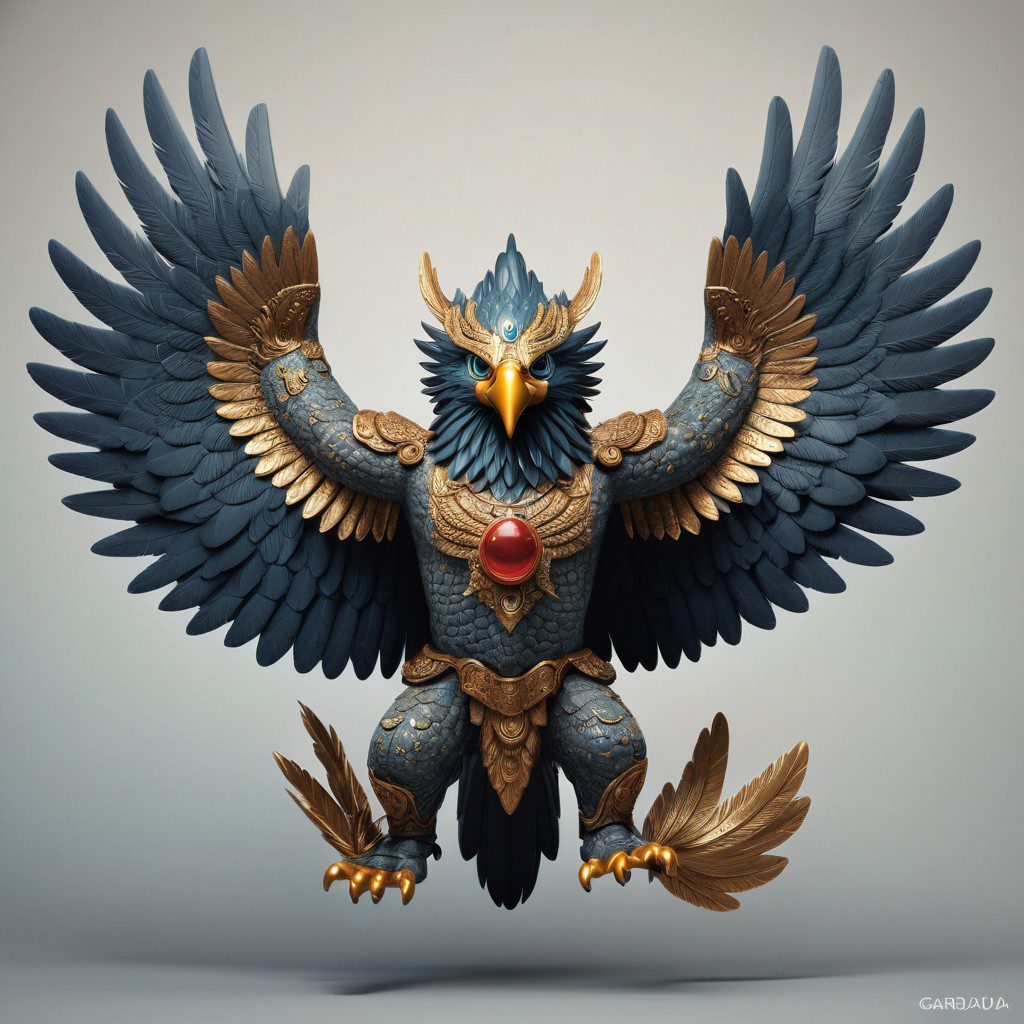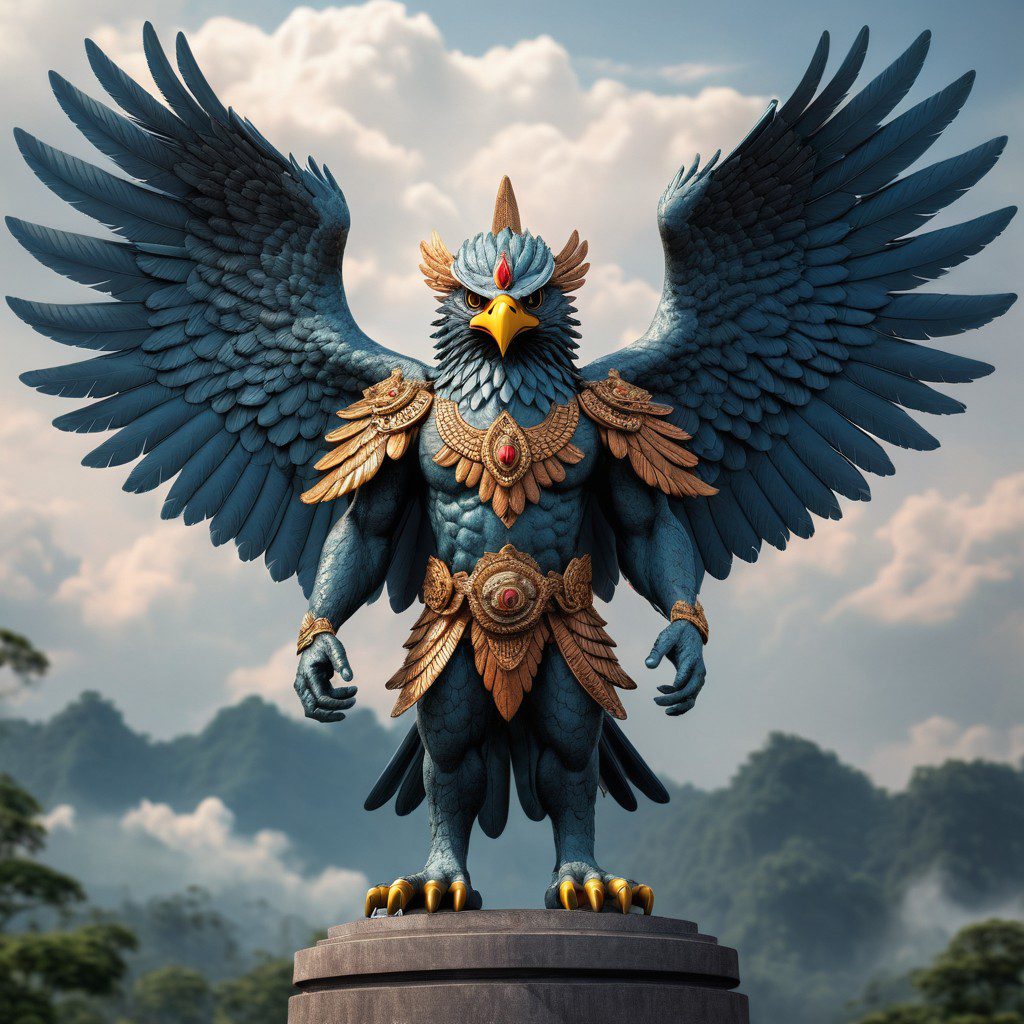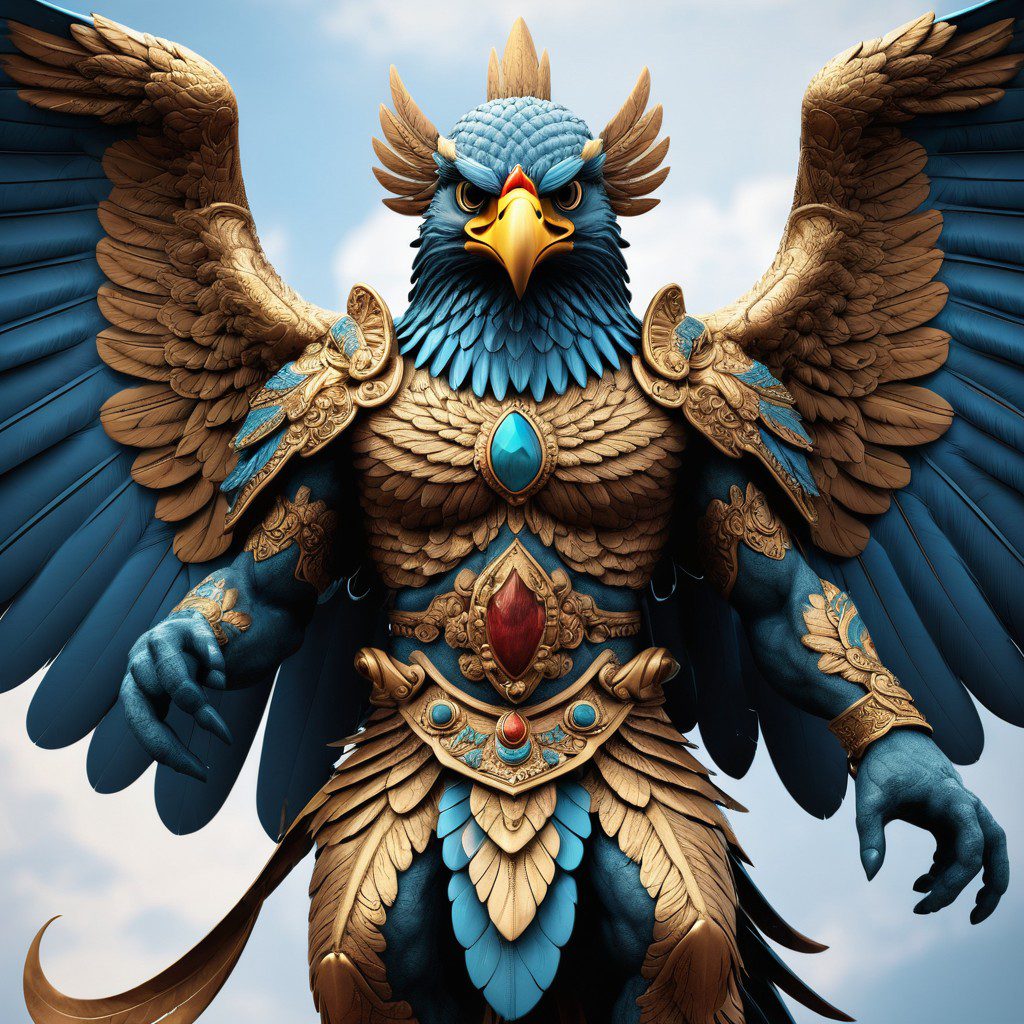Garuda: The Mighty Bird King and Divine Mount in Hindu and Buddhist Mythology

In the sacred texts and epics of Hindu and Buddhist mythology, few figures are as majestic and revered as Garuda, the mighty bird king. With the body of a powerful man, the wings and beak of an eagle, and an awe-inspiring stature, Garuda is a symbol of speed, strength, and protection. Often depicted as the vahana (divine mount) of the god Vishnu, Garuda serves as a defender of the cosmos and a tireless enemy of serpents, especially the Nagas. As both a divine being and a protector, Garuda occupies a central role in the rich spiritual traditions of South and Southeast Asia.
The Origins of Garuda
Garuda’s origins are found in the Vedas, the ancient sacred texts of Hinduism, where he is described as a divine being with unparalleled might and the ability to travel between the heavens and the earth. Over time, Garuda’s role expanded in later Hindu epics, particularly in the Mahabharata and Ramayana, where he is further detailed as the king of birds and the chosen mount of Vishnu, the preserver of the universe.
According to Hindu mythology, Garuda was born to Vinata, one of the wives of the sage Kashyapa. His mother, Vinata, had lost a bet to her co-wife Kadru, the mother of the serpent race (the Nagas), and as a result, was forced to serve Kadru and her snake-children as a slave. This led to a bitter enmity between Garuda and the Nagas. To free his mother from her servitude, Garuda embarked on a quest to obtain amrita, the nectar of immortality, which Kadru demanded in exchange for Vinata’s freedom.
Garuda successfully seized the amrita after a series of divine battles and adventures, earning not only his mother’s freedom but also a place among the gods. His loyalty and dedication to Vishnu later earned him the honor of being Vishnu’s personal mount, granting Garuda a place in the pantheon as a symbol of power, protection, and unwavering devotion.
Garuda’s Appearance: The Majestic Bird King
Garuda is typically depicted as a gigantic bird or a humanoid figure with the body of a man and the wings, beak, and talons of an eagle or hawk. His immense size allows him to block out the sun as he flies through the skies, and his golden or radiant form symbolizes divine light and the power of the sun. In some depictions, Garuda has multiple heads and arms, further emphasizing his divine and fearsome nature.
Garuda’s eyes are often described as fiery, with the ability to reduce enemies to ashes simply by his gaze. His wings are said to carry the sound of thunder when he flies, and his presence brings with it a sense of protection and righteousness. Garuda is sometimes shown holding serpents or Nagas in his claws, representing his role as the eternal enemy of these serpentine beings.
His golden feathers are also symbolic of the sun, light, and immortality, reflecting his role as a celestial being who can travel effortlessly between the earthly realm and the divine heavens. As the vahana of Vishnu, Garuda is often depicted in art and sculpture carrying Vishnu on his back, soaring across the skies with grace and power.
The Role of Garuda in Hindu Mythology
Garuda’s most important role in Hindu mythology is as the vahana of Vishnu, one of the principal deities of the Hindu pantheon who is responsible for preserving and maintaining the universe. In this capacity, Garuda serves as both a protector and a warrior, carrying Vishnu into battle against forces of evil and chaos. Garuda is loyal and unwavering in his devotion to Vishnu, and their partnership represents the balance of power, wisdom, and righteousness.

Garuda’s eternal struggle with the Nagas is one of the most enduring aspects of his myth. As natural enemies of serpents, Garuda and the Nagas are locked in an eternal battle, with Garuda often depicted capturing or subduing these serpentine beings. The enmity between Garuda and the Nagas is symbolic of the cosmic battle between good and evil, light and darkness, and order and chaos.
In addition to his role as Vishnu’s mount and serpent-slayer, Garuda is also seen as a symbol of freedom, strength, and protection. His image is often used to ward off evil spirits, serpents, and malevolent forces. In some traditions, particularly in Southeast Asia, Garuda is considered a protective deity who watches over the righteous and punishes the wicked.
Garuda in Buddhist Tradition
Garuda also plays a prominent role in Buddhist mythology, where he is known as one of the “Heavenly Kings” or “Celestial Birds”. In Buddhist texts, Garuda is described as a gigantic bird-like creature that can spread its wings and soar across vast distances in a single flight. He is often depicted as a protector of the Buddha and the Dharma, symbolizing the strength needed to overcome obstacles on the path to enlightenment.
In Buddhist cosmology, Garuda is sometimes portrayed as a being that lives in the Himalayas or at the summit of Mount Meru, the center of the physical and spiritual universe in Buddhist and Hindu cosmology. Garuda’s association with high, sacred places reinforces his role as a celestial being who exists beyond the ordinary world.
Though Garuda in Buddhism does not have the same serpent-slaying characteristics as in Hinduism, he remains a powerful protector and symbol of the forces that guard the faithful from harm. His figure is often invoked in Tibetan Buddhism to ward off danger and evil spirits, reflecting his protective qualities.
Garuda in Southeast Asian Culture

Garuda is not only revered in Hindu and Buddhist traditions but also holds a significant place in the cultures of Southeast Asia, especially in countries like Indonesia and Thailand. In these regions, Garuda has become a national symbol of strength, freedom, and unity.
In Indonesia, Garuda is the national emblem, representing the country’s struggle for independence and its strength as a sovereign nation. The Garuda Pancasila, Indonesia’s national coat of arms, features the golden bird holding a banner that symbolizes the nation’s guiding principles. Garuda is also featured in Indonesian airlines’ name, Garuda Indonesia, symbolizing speed, grace, and power.
In Thailand, Garuda is known as Phra Khrut Pha, where he is considered a royal emblem and is closely associated with the Thai monarchy. His image can be seen in many temples, palaces, and royal buildings throughout the country, symbolizing the protection of the nation and the king.
Strengths and Weaknesses of Garuda
Strengths:
- Unparalleled Strength and Speed: As the king of birds, Garuda possesses immense physical strength and speed, capable of carrying the god Vishnu into battle and traveling vast distances with ease.
- Protector and Warrior: Garuda is the eternal enemy of serpents and a defender of righteousness. His presence wards off evil, making him a powerful ally and guardian in both Hindu and Buddhist traditions.
- Symbol of Freedom and Light: Garuda’s association with the sun and his golden feathers make him a symbol of enlightenment, wisdom, and freedom, bringing divine light and clarity to those who call upon him.
- Loyalty to Vishnu: Garuda’s unwavering devotion to Vishnu underscores his role as a loyal protector of the cosmos, always ready to aid the god in his mission to preserve balance and righteousness.
Weaknesses:
- Enmity with Nagas: Garuda’s eternal battle with the Nagas symbolizes his role as an enemy of serpents, but this also binds him to a cosmic struggle that is ongoing and difficult to fully resolve.
- Dependent on Vishnu: Though powerful on his own, Garuda’s greatest strength comes from his partnership with Vishnu. His role as a divine mount sometimes places him in a subservient position, rather than as a completely independent deity.
- Celestial Limits: While Garuda is a protector and warrior, his focus on cosmic and spiritual battles may limit his influence in more mundane, earthly matters.
The Legacy of Garuda
Garuda remains one of the most iconic figures in Hindu, Buddhist, and Southeast Asian mythology, representing the ideals of freedom, strength, and protection. As the vahana of Vishnu, Garuda embodies the balance of power and grace, soaring through the skies as a protector of the cosmos. His image, from the sacred texts of the Mahabharata to the royal emblems of Thailand and Indonesia, continues to inspire reverence and admiration in those who seek strength in the face of adversity.
Whether as a warrior king of birds or a symbol of national pride, Garuda’s influence transcends mythology, serving as a powerful reminder of the eternal struggle between good and evil, light and darkness, and the protection of the righteous.
